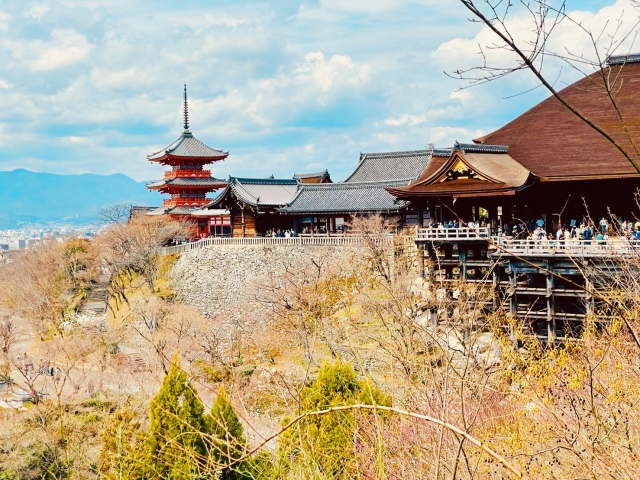Marvel at the architectural splendor and rich history of Kiyomizu-dera, one of the most iconic landmarks in Kyoto, beloved by locals and international visitors alike.

A Glimpse into Kiyomizu-dera’s Rich History
Founded in 778, Kiyomizu-dera is one of the oldest temples in Japan and has become synonymous with the city of Kyoto. Its name, meaning “Pure Water Temple,” comes from the Otawa Waterfall running through the temple grounds. This UNESCO World Heritage Site, nestled in the eastern hills of Kyoto, is a testament to Japan’s rich cultural and spiritual heritage.
Architectural Marvel: The Main Hall
Kiyomizu-dera’s Main Hall is a striking example of traditional Japanese architecture. Built without a single nail, this wooden marvel offers breathtaking views over Kyoto. The spacious terrace, supported by hundreds of pillars, is a sight to behold, particularly during the cherry blossom and autumn foliage seasons.
Experience Kiyomizu Stage
The stage of the Main Hall, known as Kiyomizu Stage, juts out over the hillside below. Here, visitors can soak up panoramic views of Kyoto city — a sight that becomes even more mesmerizing during the annual illuminations of spring and autumn.
Discover Jishu Shrine
Within Kiyomizu-dera’s premises lies Jishu Shrine, a place dedicated to Ōkuninushi, a god of love and good matches. Its pair of “love stones” set 18 meters apart promises good fortune to those who can walk between them blindfolded. This fun and meaningful activity attracts both singles seeking love and couples seeking to strengthen their bond.
Otawa Waterfall: Pure Waters for Good Fortune
The Otawa Waterfall, situated at the base of the main hall, is another must-see feature. The waterfall is divided into three streams, each signifying a different benefit: longevity, academic success, and a fruitful love life. Visitors use cups attached to long poles to drink from these streams, seeking blessings for their chosen aspect of life.
Annual Events and Seasons at Kiyomizu-dera
Kiyomizu-dera is spectacular all year round, but the temple’s beauty shines the brightest during cherry blossom season and autumn. The temple is usually crowded during these periods, but the breathtaking scenery is well worth the visit. Moreover, the temple hosts several special events throughout the year, such as the “Night Visits” (Yoiyama) during Kyoto’s Gion Matsuri festival in July.
The Magic of Cherry Blossom Season
Visiting Kiyomizu-dera in the spring is a captivating experience. The temple grounds burst into a sea of pink, as cherry blossom trees bloom in their full glory. The beautiful contrast between the vibrant blossoms and the historic temple structures creates a truly magical atmosphere.
Autumn Colors at Kiyomizu-dera
Autumn at Kiyomizu-dera is an equally enchanting experience. The temple grounds transform into a vibrant display of red, orange, and gold. The trees surrounding the main hall’s large veranda offer a stunning fall foliage view, made even more spectacular during the special night illuminations.
Practical Information for Your Visit
Visitors can reach Kiyomizu-dera by bus from Kyoto Station. The temple is also just a 15-minute walk uphill from Kiyomizu-Gojo Station. Please remember that as a sacred religious site, respectful attire and behavior are required at all times.
Temple Opening Hours
Kiyomizu-dera is open from 6 am to 6 pm throughout the year, with extended hours during certain periods of spring and autumn. Please note that the temple requires a small entrance fee.
Conclusion
With its stunning beauty and cultural significance, Kiyomizu-dera is more than just a tourist spot—it’s a place where visitors can connect with the timeless traditions and spiritual richness of Japan. A visit to Kiyomizu-dera is a memorable experience, offering a glimpse into the heart of Kyoto’s heritage.



comment